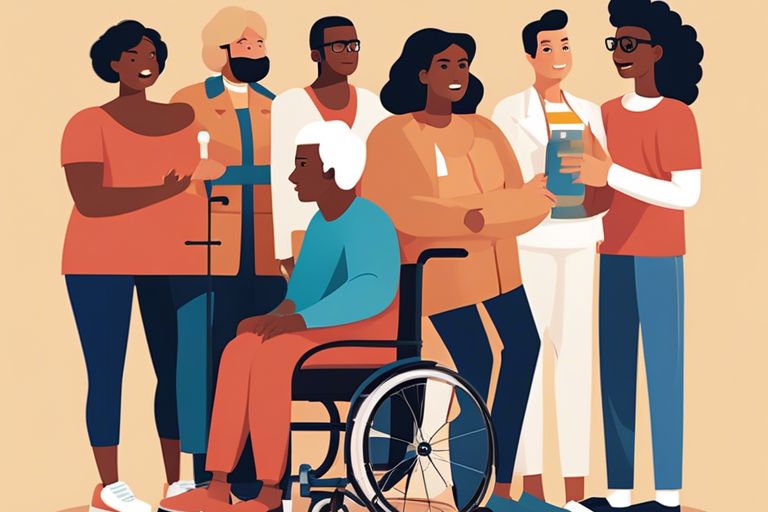For Advertising Contact Us
Disability Living Allowance – What Illnesses Qualify for UK DLA (Child & Adults)?

Disability Living Allowance (DLA) is a UK government benefit aimed at helping individuals with disabilities meet the extra costs they may face due to their condition. DLA is available for both children and adults, and the amount received depends on how the disability affects daily living and mobility. To qualify for DLA, the individual must have had difficulties for at least three months and be expected to continue to have difficulties for at least another six months. Here is a comprehensive list of illnesses and disabilities that may qualify for DLA.
Childhood Conditions:
- Autism Spectrum Disorders (ASD)
- Cerebral Palsy
- Down Syndrome
- Epilepsy
- Muscular Dystrophy
- Cystic Fibrosis
- Sensory Impairments
- Attention Deficit Hyperactivity Disorder (ADHD)
- Developmental Delay
- Chronic Illnesses
Adult Conditions:
- Multiple Sclerosis (MS)
- Parkinson’s Disease
- Chronic Obstructive Pulmonary Disease (COPD)
- Arthritis
- HIV/AIDS
- Stroke
- Mental Health Conditions (Depression, Anxiety, Bipolar Disorder)
- Fibromyalgia
- Cancer
- Learning Disabilities
Eligibility Criteria for DLA
Qualifying Illnesses and Conditions
Before applying for Disability Living Allowance (DLA) in the UK, it’s important to understand the qualifying illnesses and conditions that make an individual eligible for this benefit. DLA is primarily granted to individuals with severe physical or mental health conditions that significantly impact their daily lives. Common qualifying illnesses may include but are not limited to chronic conditions such as multiple sclerosis, Parkinson’s disease, cerebral palsy, and severe mental health disorders like schizophrenia or bipolar disorder.
To qualify for DLA, the illness or condition must be long-term (lasting at least 12 months) and severe enough to require assistance or supervision with daily living activities or mobility. The severity of the condition is assessed based on how it affects the individual’s ability to perform tasks such as dressing, eating, bathing, walking, and communicating.
Age Requirements: Children and Adults
Eligibility for DLA varies based on age, with separate criteria for children and adults. Children under 16 years of age can qualify for DLA if they have difficulties with personal care or mobility that are significantly greater than those of a child of the same age without a disability. Adults over 16 years old must also meet the eligibility criteria based on their own care and mobility needs.
It’s important to note that DLA can provide crucial financial support for individuals with qualifying disabilities to help cover the extra costs of living with a disability. The amount of DLA awarded is based on the level of care or mobility assistance needed and is tax-free.
Types of DLA Support
Little is known about the various types of support available under the Disability Living Allowance (DLA) in the UK. It is crucial for individuals with disabilities to understand the different components of DLA to determine their eligibility and receive the appropriate financial assistance. The DLA support is divided into two main components: Care Component and Mobility Component.
| Care Component | Mobility Component |
| Support with personal care and supervision needs | Support with mobility needs |
| For those who require assistance with daily living activities | For those who have difficulty walking or need help getting around |
| Covers day and night care | Assists with transportation and outdoor mobility |
| Can be claimed at different rates based on care needs | Can be claimed at different rates depending on mobility limitations |
| Available for both children and adults | Available for both children and adults |
Care Component
Component: The Care Component of DLA is designed to provide financial support for individuals who require assistance with personal care or supervision needs. This component helps cover the costs associated with day and night care, ensuring that individuals with disabilities can receive the necessary support to carry out their daily activities. Depending on the level of care needed, individuals can claim the Care Component at different rates to receive adequate financial assistance.
To access the Care Component of DLA, individuals must undergo a thorough assessment to determine their eligibility based on their care needs. The assessment takes into account the individual’s ability to perform daily living activities independently and identifies the level of support required. It is crucial to provide accurate and detailed information during the assessment process to ensure a fair evaluation of care needs.
Mobility Component
To access the Mobility Component of DLA, individuals must undergo a separate assessment focused on their mobility limitations and needs. This component provides financial support for individuals who have difficulty walking or require assistance with transportation and outdoor mobility. The Mobility Component helps cover the costs associated with mobility aids and equipment to enhance the individual’s independence and quality of life.
This component is crucial for individuals with disabilities who face challenges in moving around independently. The Mobility Component offers different rates of financial support based on the severity of mobility limitations, ensuring that individuals receive the necessary assistance to improve their mobility and access to crucial services. Perceiving the importance of the Mobility Component can help individuals with disabilities navigate daily life with greater ease and independence.
Applying for Disability Living Allowance
Now that you have determined that you are eligible for Disability Living Allowance (DLA), it’s time to start the application process. Applying for DLA can be overwhelming, but with the right information and guidance, the process can be more manageable.
For a smooth application experience, follow the step-by-step guide outlined below to ensure you submit a successful DLA application.
Step-by-Step Guide to the Application Process
Below is a breakdown of the application process for Disability Living Allowance:
| Step 1: | Gather all relevant medical documentation and information. |
| Step 2: | Download the DLA application form from the official government website or request a hard copy via mail. |
| Step 3: | Complete the form accurately and provide detailed information about the disability and its impact on daily living. |
| Step 4: | Submit the application form along with any supporting documents to the DLA office. |
Tips for Submitting a Successful DLA Application
When submitting your DLA application, consider the following tips to increase your chances of approval:
- Provide detailed descriptions: Clearly explain how the disability affects daily activities and care needs.
- Include supporting evidence: Attach medical reports, doctor’s letters, and any other relevant documents to strengthen your case.
- Be honest and thorough: Ensure all information provided is accurate and complete to avoid delays or complications in the assessment process.
Guide yourself through the DLA application process with these tips in mind to maximize your chances of a successful outcome. Submission of a well-prepared application will not only expedite the process but also increase the likelihood of approval. Perceiving the application as an opportunity to provide a comprehensive overview of your needs can significantly impact the decision-making process.
Factors Influencing DLA Decisions
After submitting an application for Disability Living Allowance (DLA), the decision on eligibility is based on various factors. It is imperative to understand what influences the outcome of DLA applications for both children and adults.
Severity and Impact of Disability
The severity and impact of the disability on daily living activities play a significant role in determining DLA eligibility. Assessors consider how the disability affects the individual’s ability to carry out tasks such as personal care, mobility, and communication. They evaluate the level of support needed and the impact on overall quality of life.
The assessors will also take into account the fluctuating nature of some disabilities. Conditions that vary in intensity or are unpredictable can also qualify for DLA if they have a substantial impact on daily life. Knowing how to effectively communicate the severity and impact of the disability is crucial in the assessment process.
Required Documentation and Evidence
One of the key factors in DLA decisions is the availability of necessary documentation and evidence to support the application. Medical reports, assessments from healthcare professionals, and details of treatments and medications are vital in proving the existence and impact of the disability.
Influencing the decision are also statements from caregivers, school reports, and any other relevant information that can provide a comprehensive picture of the individual’s needs. Providing thorough and up-to-date documentation is crucial in supporting the application for DLA.
Pros and Cons of Receiving DLA
Once again, disability living allowance (DLA) can offer a lifeline to individuals with disabilities in the UK. However, like any benefit system, there are both advantages and potential drawbacks to receiving DLA. Here we break down the pros and cons to help you make an informed decision.
| Pros | Cons |
| Financial support for daily living and mobility needs | Potential delays or challenges in the application process |
| Helps cover additional costs related to disability | Periodic reassessments may cause stress and uncertainty |
| May qualify you for other benefits or support services | Public scrutiny and stigma attached to receiving benefits |
| Can improve access to healthcare and specialized treatments | Possible reduction in other forms of financial assistance |
| Provides financial stability and peace of mind | Changes in personal circumstances may impact eligibility |
Financial Benefits and How They Help
One of the significant advantages of receiving Disability Living Allowance is the financial benefits it provides. This support can help individuals with disabilities cover the additional costs of living with their condition, such as purchasing specialized equipment, accessing transportation services, or modifying living spaces to accommodate their needs. The financial assistance can offer a sense of security and enable individuals to maintain a certain quality of life despite the challenges they face.
The additional funds from DLA can also open up opportunities for individuals to access better healthcare services or treatments that may not have been affordable otherwise. This can lead to improved health outcomes and overall well-being for the recipients, demonstrating the tangible impact that financial support can have on the lives of those with disabilities.
Potential Challenges and Considerations
The process of applying for and receiving DLA is not without its challenges and considerations. Potential delays or complications in the application process can be frustrating for individuals in need of immediate financial assistance. Additionally, the periodic reassessments required to maintain DLA eligibility can be anxiety-inducing and disruptive to the lives of recipients. The uncertainty surrounding these reassessments can cause stress and emotional strain on individuals already dealing with health issues.
Conclusion
Considering all points, Disability Living Allowance (DLA) in the UK is a crucial financial support for those with specific illnesses or disabilities that impact their everyday living. Both children and adults can qualify if they have conditions such as physical or mental disabilities, chronic illnesses, or disorders that affect mobility or independent living. Understanding the qualifying criteria for DLA is important for individuals seeking financial assistance for their disability-related needs in the UK.



